Honeywell 2003 Annual Report Download - page 417
Download and view the complete annual report
Please find page 417 of the 2003 Honeywell annual report below. You can navigate through the pages in the report by either clicking on the pages listed below, or by using the keyword search tool below to find specific information within the annual report.-
 1
1 -
 2
2 -
 3
3 -
 4
4 -
 5
5 -
 6
6 -
 7
7 -
 8
8 -
 9
9 -
 10
10 -
 11
11 -
 12
12 -
 13
13 -
 14
14 -
 15
15 -
 16
16 -
 17
17 -
 18
18 -
 19
19 -
 20
20 -
 21
21 -
 22
22 -
 23
23 -
 24
24 -
 25
25 -
 26
26 -
 27
27 -
 28
28 -
 29
29 -
 30
30 -
 31
31 -
 32
32 -
 33
33 -
 34
34 -
 35
35 -
 36
36 -
 37
37 -
 38
38 -
 39
39 -
 40
40 -
 41
41 -
 42
42 -
 43
43 -
 44
44 -
 45
45 -
 46
46 -
 47
47 -
 48
48 -
 49
49 -
 50
50 -
 51
51 -
 52
52 -
 53
53 -
 54
54 -
 55
55 -
 56
56 -
 57
57 -
 58
58 -
 59
59 -
 60
60 -
 61
61 -
 62
62 -
 63
63 -
 64
64 -
 65
65 -
 66
66 -
 67
67 -
 68
68 -
 69
69 -
 70
70 -
 71
71 -
 72
72 -
 73
73 -
 74
74 -
 75
75 -
 76
76 -
 77
77 -
 78
78 -
 79
79 -
 80
80 -
 81
81 -
 82
82 -
 83
83 -
 84
84 -
 85
85 -
 86
86 -
 87
87 -
 88
88 -
 89
89 -
 90
90 -
 91
91 -
 92
92 -
 93
93 -
 94
94 -
 95
95 -
 96
96 -
 97
97 -
 98
98 -
 99
99 -
 100
100 -
 101
101 -
 102
102 -
 103
103 -
 104
104 -
 105
105 -
 106
106 -
 107
107 -
 108
108 -
 109
109 -
 110
110 -
 111
111 -
 112
112 -
 113
113 -
 114
114 -
 115
115 -
 116
116 -
 117
117 -
 118
118 -
 119
119 -
 120
120 -
 121
121 -
 122
122 -
 123
123 -
 124
124 -
 125
125 -
 126
126 -
 127
127 -
 128
128 -
 129
129 -
 130
130 -
 131
131 -
 132
132 -
 133
133 -
 134
134 -
 135
135 -
 136
136 -
 137
137 -
 138
138 -
 139
139 -
 140
140 -
 141
141 -
 142
142 -
 143
143 -
 144
144 -
 145
145 -
 146
146 -
 147
147 -
 148
148 -
 149
149 -
 150
150 -
 151
151 -
 152
152 -
 153
153 -
 154
154 -
 155
155 -
 156
156 -
 157
157 -
 158
158 -
 159
159 -
 160
160 -
 161
161 -
 162
162 -
 163
163 -
 164
164 -
 165
165 -
 166
166 -
 167
167 -
 168
168 -
 169
169 -
 170
170 -
 171
171 -
 172
172 -
 173
173 -
 174
174 -
 175
175 -
 176
176 -
 177
177 -
 178
178 -
 179
179 -
 180
180 -
 181
181 -
 182
182 -
 183
183 -
 184
184 -
 185
185 -
 186
186 -
 187
187 -
 188
188 -
 189
189 -
 190
190 -
 191
191 -
 192
192 -
 193
193 -
 194
194 -
 195
195 -
 196
196 -
 197
197 -
 198
198 -
 199
199 -
 200
200 -
 201
201 -
 202
202 -
 203
203 -
 204
204 -
 205
205 -
 206
206 -
 207
207 -
 208
208 -
 209
209 -
 210
210 -
 211
211 -
 212
212 -
 213
213 -
 214
214 -
 215
215 -
 216
216 -
 217
217 -
 218
218 -
 219
219 -
 220
220 -
 221
221 -
 222
222 -
 223
223 -
 224
224 -
 225
225 -
 226
226 -
 227
227 -
 228
228 -
 229
229 -
 230
230 -
 231
231 -
 232
232 -
 233
233 -
 234
234 -
 235
235 -
 236
236 -
 237
237 -
 238
238 -
 239
239 -
 240
240 -
 241
241 -
 242
242 -
 243
243 -
 244
244 -
 245
245 -
 246
246 -
 247
247 -
 248
248 -
 249
249 -
 250
250 -
 251
251 -
 252
252 -
 253
253 -
 254
254 -
 255
255 -
 256
256 -
 257
257 -
 258
258 -
 259
259 -
 260
260 -
 261
261 -
 262
262 -
 263
263 -
 264
264 -
 265
265 -
 266
266 -
 267
267 -
 268
268 -
 269
269 -
 270
270 -
 271
271 -
 272
272 -
 273
273 -
 274
274 -
 275
275 -
 276
276 -
 277
277 -
 278
278 -
 279
279 -
 280
280 -
 281
281 -
 282
282 -
 283
283 -
 284
284 -
 285
285 -
 286
286 -
 287
287 -
 288
288 -
 289
289 -
 290
290 -
 291
291 -
 292
292 -
 293
293 -
 294
294 -
 295
295 -
 296
296 -
 297
297 -
 298
298 -
 299
299 -
 300
300 -
 301
301 -
 302
302 -
 303
303 -
 304
304 -
 305
305 -
 306
306 -
 307
307 -
 308
308 -
 309
309 -
 310
310 -
 311
311 -
 312
312 -
 313
313 -
 314
314 -
 315
315 -
 316
316 -
 317
317 -
 318
318 -
 319
319 -
 320
320 -
 321
321 -
 322
322 -
 323
323 -
 324
324 -
 325
325 -
 326
326 -
 327
327 -
 328
328 -
 329
329 -
 330
330 -
 331
331 -
 332
332 -
 333
333 -
 334
334 -
 335
335 -
 336
336 -
 337
337 -
 338
338 -
 339
339 -
 340
340 -
 341
341 -
 342
342 -
 343
343 -
 344
344 -
 345
345 -
 346
346 -
 347
347 -
 348
348 -
 349
349 -
 350
350 -
 351
351 -
 352
352 -
 353
353 -
 354
354 -
 355
355 -
 356
356 -
 357
357 -
 358
358 -
 359
359 -
 360
360 -
 361
361 -
 362
362 -
 363
363 -
 364
364 -
 365
365 -
 366
366 -
 367
367 -
 368
368 -
 369
369 -
 370
370 -
 371
371 -
 372
372 -
 373
373 -
 374
374 -
 375
375 -
 376
376 -
 377
377 -
 378
378 -
 379
379 -
 380
380 -
 381
381 -
 382
382 -
 383
383 -
 384
384 -
 385
385 -
 386
386 -
 387
387 -
 388
388 -
 389
389 -
 390
390 -
 391
391 -
 392
392 -
 393
393 -
 394
394 -
 395
395 -
 396
396 -
 397
397 -
 398
398 -
 399
399 -
 400
400 -
 401
401 -
 402
402 -
 403
403 -
 404
404 -
 405
405 -
 406
406 -
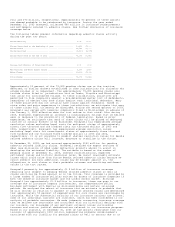 407
407 -
 408
408 -
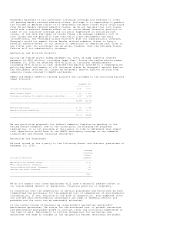 409
409 -
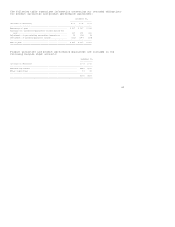 410
410 -
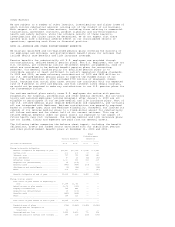 411
411 -
 412
412 -
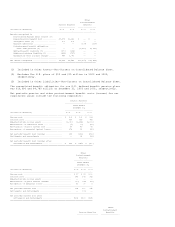 413
413 -
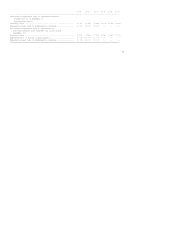 414
414 -
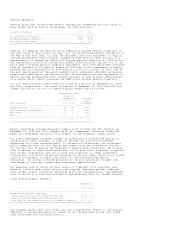 415
415 -
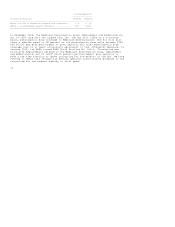 416
416 -
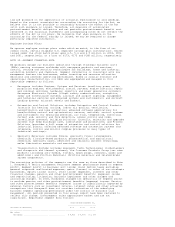 417
417 -
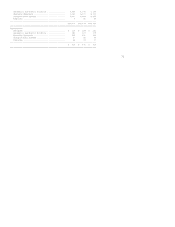 418
418 -
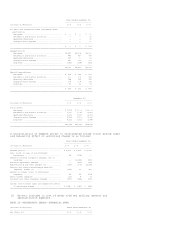 419
419 -
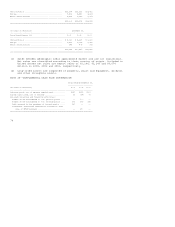 420
420 -
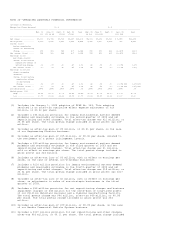 421
421 -
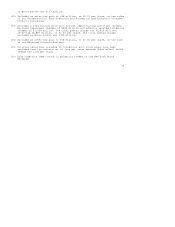 422
422 -
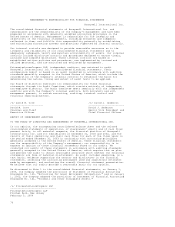 423
423 -
 424
424 -
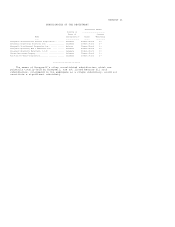 425
425 -
 426
426 -
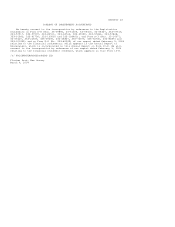 427
427 -
 428
428 -
 429
429 -
 430
430 -
 431
431 -
 432
432 -
 433
433 -
 434
434 -
 435
435 -
 436
436 -
 437
437 -
 438
438 -
 439
439 -
 440
440 -
 441
441 -
 442
442 -
 443
443 -
 444
444
 |
 |
ing and guidance on the application of actuarial equivalence is also pending.
Based on the current uncertainties surrounding the accounting for the Act, we
believe that it is not possible to reasonably estimate the effect of the Act
until such guidance is issued. Therefore, all measures of accumulated
postretirement benefit obligation and net periodic postretirement benefit cost
reflected in the financial statements and accompanying notes do not reflect the
effects of the Act on our plans. We recognize that when guidance on the
accounting for the federal subsidy is issued, we may be required to change
previously reported information.
Employee Savings Plans
We sponsor employee savings plans under which we match, in the form of our
common stock, certain eligible U.S. employee savings plan contributions. Shares
issued under the stock match plans were 6.5, 5.6 and 4.9 million in 2003, 2002
and 2001, respectively, at a cost of $173, $173 and $185 million, respectively.
NOTE 23--SEGMENT FINANCIAL DATA
We globally manage our business operations through strategic business units
(SBUs) serving customers worldwide with aerospace products and services,
control, sensing and security technologies for buildings, homes and industry,
automotive products and chemicals. Segment information is consistent with how
management reviews the businesses, makes investing and resource allocation
decisions and assesses operating performance. Based on similar economic and
operational characteristics, our SBUs are aggregated and managed in four
reportable segments as follows:
o Aerospace includes Engines, Systems and Services (auxiliary power units;
propulsion engines; environmental control systems; engine controls; repair
and overhaul services; hardware; logistics and power generation systems);
Aerospace Electronic Systems (flight safety communications, navigation,
radar and surveillance systems; aircraft and airport lighting; management
and technical services and advanced systems and instruments); and Aircraft
Landing Systems (aircraft wheels and brakes).
o Automation and Control Solutions includes Automation and Control Products
(controls for heating, cooling, indoor air quality, ventilation,
humidification and home automation; advanced software applications for
home/building control and optimization; sensors, switches, control systems
and instruments for measuring pressure, air flow, temperature, electrical
current and, security and fire detection, access control and video
surveillance systems); Building Solutions (installs, maintains and upgrades
systems that keep buildings safe, comfortable and productive); and Process
Solutions (provides a full range of automation and control solutions for
industrial plants, offering advanced software and automation systems that
integrate, control and monitor complex processes in many types of
industrial settings).
o Specialty Materials includes fibers; specialty films; intermediate
chemicals; fluorine-based products; pharmaceutical and agricultural
chemicals; specialty waxes, adhesives and sealants; process technology;
wafer fabrication materials and services.
o Transportation Systems includes Honeywell Turbo Technologies (turbochargers
and charge-air and thermal systems); the Consumer Products Group (car care
products including anti-freeze, filters, spark plugs, cleaners, waxes and
additives); and Friction Materials (friction materials and related brake
system components).
The accounting policies of the segments are the same as those described in Note
1. Honeywell's senior management evaluates segment performance based on segment
profit. Segment profit is business unit income (loss) before taxes excluding
general corporate unallocated expenses, gains (losses) on sales of non-strategic
businesses, equity income (loss), other income (expense), interest and other
financial charges, pension and other postretirement benefits (expense) income
and repositioning, litigation, business impairment and other charges and
accounting changes. In 2003, Honeywell changed its definition of segment profit
to exclude pension and other postretirement benefits (expense) income. Pension
and other postretirement benefits (expense) income is significantly impacted by
external factors such as investment returns, interest rates and other actuarial
assumptions that Honeywell does not consider indicative of the underlying
business segment operating performance under the control of business unit
management. All periods presented in this annual report have been restated to
reflect this change. Intersegment sales approximate market and are not
significant. Reportable segment data follows:
Years Ended December 31,
---------------------------
(Dollars in Millions) 2003 2002 2001
-----------------------------------------------------------------------------------
Net sales
Aerospace ........................................ $ 8,813 $ 8,855 $ 9,653
